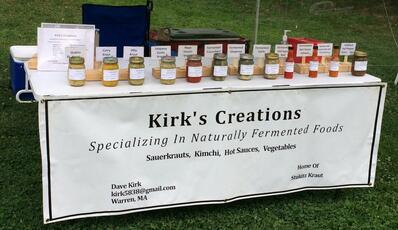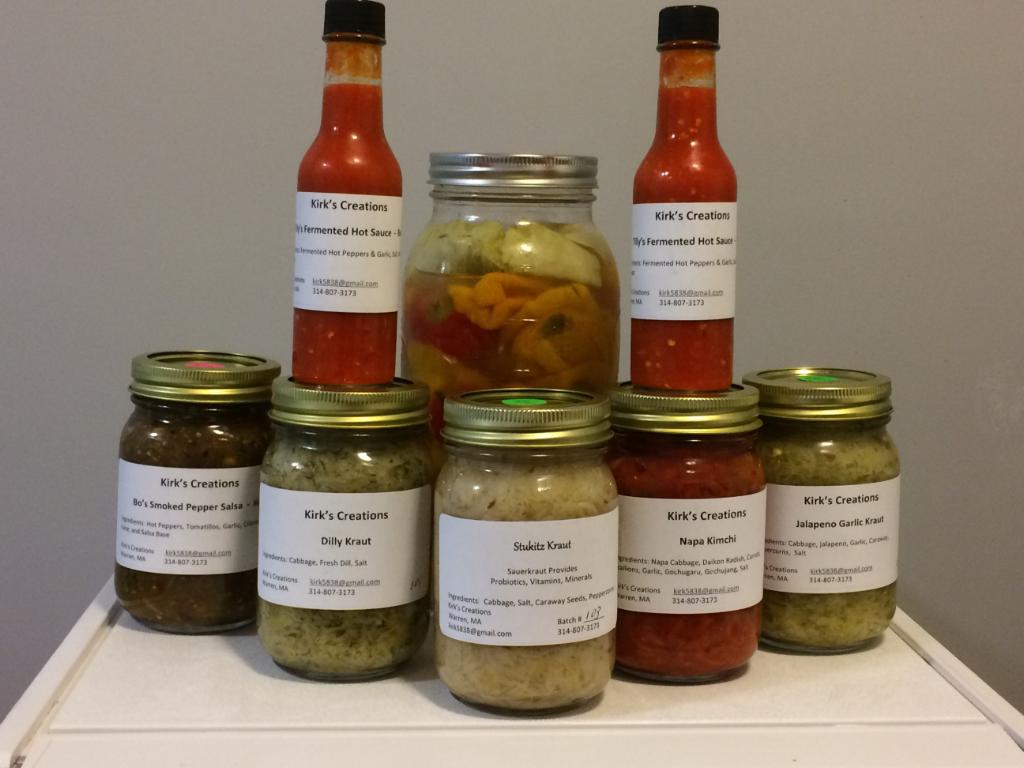 The Amherst Farmers’ Market welcomes back Kirk’s Creations. First joining the market in 2017, David Kirk introduced his family’s recipes for lacto-fermented deliciousness. The list of lactic acid fermented foods is long. kimchi, sauerkraut, and dill pickles; several styles of hot sauces and chile pastes; cultured dairy products like yogurt, crème fraîche, and cheese; kombucha, salami, and, yes, even sourdough bread. To quote Sandor Katz, in The Art of Fermentation, “I have searched—without success—for examples of cultures that do not incorporate any form of [lactic acid] fermentation. Indeed, ferments are central features of many, perhaps even most, cuisines.” Lacto-fermentation experienced a resurgence during the height of COVID - hello to everyone who tried a sourdough starter - it’s far from a new trend. It’s been around for over 10,000 years and there isn't a culinary culture on the planet that doesn't present evidence of lacto-fermentation. Civilizations have been controlling fermentation for thousands of years, with some of the earliest examples being fermented beverages. A fermentation of fruit, honey, and rice discovered in Neolithic China dates back to 7000 BC. In the Caucus, wine-making dates to around 6000 BC. People were fermenting beverages in Babylon around 3000 BC. Even thousands of years before fermented alcoholic beverages were developed, fermentation was occurring with a food known for notoriously poor holding qualities – dairy. The milk of camels, goats, sheep, and cattle was naturally fermented as far back as 10,000 BCE. It’s likely the fermentation spontaneously occurred, due to naturally microflora present in the milk. The climate where this dairy fermentation took place played a large role in its occurrence, as lactic acid fermentation favors the heat of this climate. The first yogurts were produced in goat bags draped over the backs of camels in the heat of North Africa, where temperatures around 110°F made ideal conditions for fermentation to occur. It wasn’t until the mid 1800s, though, that people understood what was happening to make their food ferment. In 1856, Louis Pasteur connected yeast to the process of fermentation, making him the first zymologist – studying the applied science of fermentation. He defined fermentation as, “respiration without air”. Fermentation was still being used solely to increase the holding and storing properties of food. It wasn’t until 1910 that fermented foods were first considered as beneficial to health. Leo F. Rettger of Yale concluded in 1935 that certain strains of Lactobacillus acidophilus could survive the environment of the human gut and were necessary for optimal digestion. In the last 50 years, extensive research has been conducted examining the health benefits of consuming friendly bacteria. There appear to be linkages between consuming foods containing these bacteria and improved digestion, among other areas. The popularity of “probiotic” products reflect this knowledge. Probiotics are a food/beverage that contains friendly bacteria. Products labeled with this word are all over stores – everything from yogurts to dietary supplements. Fermented foods, as Pasteur determined, are naturally high in these friendly bacteria. Let’s return to 1900 for a moment, though, and forget about the possible health benefits derived from eating fermented foods. In 1900, fermentation was a method of food preservation. Fermenting foods provided a way to store them without the need for refrigeration. While farm wives in 1900 may not have been making kimchi or kombucha, they were certainly feeding their families fermented foods such as cheese, bread, beer, and vinegar. Without giving you a full-on microbiology lesson, the basic principles of food preservation by fermentation depend on the transformative action of microbes and the manipulation of environments to encourage the action of certain desired microbes and discourage the presence or action of less desirable microbes. Fermentation is an anaerobic process, which means it occurs in an airless environment. The desirable bacteria thrive in this oxygen-free environment digesting sugars, starches, and carbohydrates and releasing alcohols, carbon dioxide, and organic acids (which are what preserve the food). The undesirable bacteria that cause spoilage, rotting, and decay of food can’t survive in this anaerobic environment
0 Comments
Leave a Reply. |
AFM Marketblog
Bringing you organic, grass-fed, pasture-raised, locally-sourced blog posts on a semi-weekly basis from the Amherst Farmers' Market. Archives
July 2022
categories...
All
|



 RSS Feed
RSS Feed
